CHEVROLET KODIAK 2007 Owners Manual
Manufacturer: CHEVROLET, Model Year: 2007, Model line: KODIAK, Model: CHEVROLET KODIAK 2007Pages: 430, PDF Size: 6.06 MB
Page 291 of 430
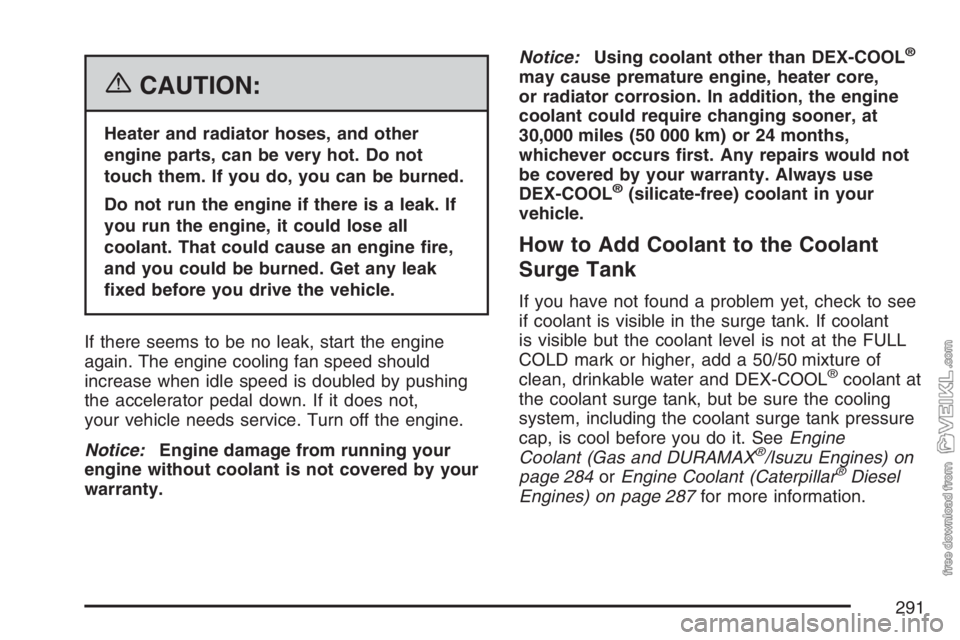
{CAUTION:
Heater and radiator hoses, and other
engine parts, can be very hot. Do not
touch them. If you do, you can be burned.
Do not run the engine if there is a leak. If
you run the engine, it could lose all
coolant. That could cause an engine �re,
and you could be burned. Get any leak
�xed before you drive the vehicle.
If there seems to be no leak, start the engine
again. The engine cooling fan speed should
increase when idle speed is doubled by pushing
the accelerator pedal down. If it does not,
your vehicle needs service. Turn off the engine.
Notice:Engine damage from running your
engine without coolant is not covered by your
warranty.Notice:Using coolant other than DEX-COOL
®
may cause premature engine, heater core,
or radiator corrosion. In addition, the engine
coolant could require changing sooner, at
30,000 miles (50 000 km) or 24 months,
whichever occurs �rst. Any repairs would not
be covered by your warranty. Always use
DEX-COOL
®(silicate-free) coolant in your
vehicle.
How to Add Coolant to the Coolant
Surge Tank
If you have not found a problem yet, check to see
if coolant is visible in the surge tank. If coolant
is visible but the coolant level is not at the FULL
COLD mark or higher, add a 50/50 mixture of
clean, drinkable water and DEX-COOL
®coolant at
the coolant surge tank, but be sure the cooling
system, including the coolant surge tank pressure
cap, is cool before you do it. SeeEngine
Coolant (Gas and DURAMAX
®/Isuzu Engines) on
page 284orEngine Coolant (Caterpillar®Diesel
Engines) on page 287for more information.
291
Page 292 of 430
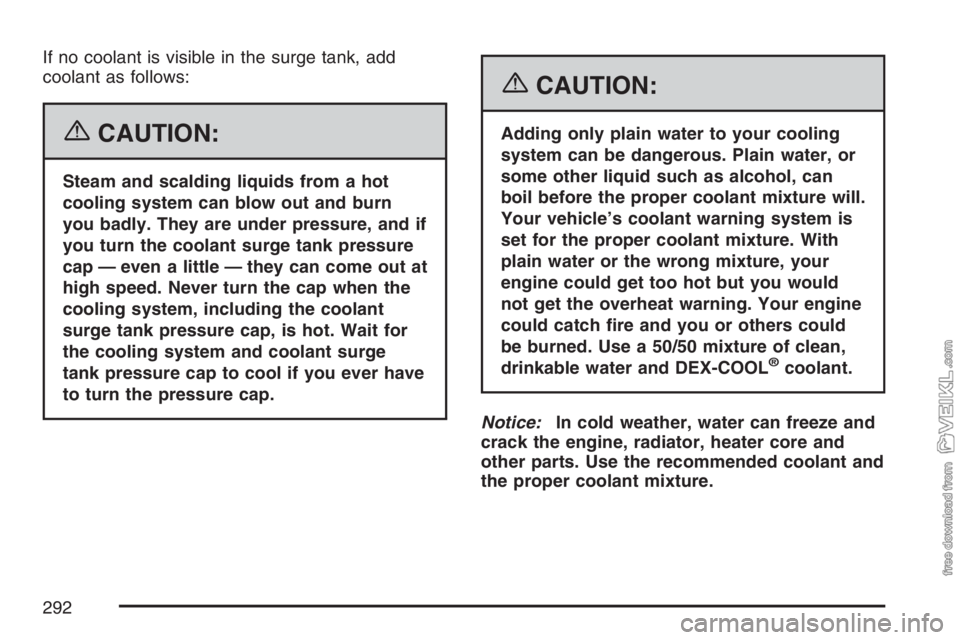
If no coolant is visible in the surge tank, add
coolant as follows:
{CAUTION:
Steam and scalding liquids from a hot
cooling system can blow out and burn
you badly. They are under pressure, and if
you turn the coolant surge tank pressure
cap — even a little — they can come out at
high speed. Never turn the cap when the
cooling system, including the coolant
surge tank pressure cap, is hot. Wait for
the cooling system and coolant surge
tank pressure cap to cool if you ever have
to turn the pressure cap.
{CAUTION:
Adding only plain water to your cooling
system can be dangerous. Plain water, or
some other liquid such as alcohol, can
boil before the proper coolant mixture will.
Your vehicle’s coolant warning system is
set for the proper coolant mixture. With
plain water or the wrong mixture, your
engine could get too hot but you would
not get the overheat warning. Your engine
could catch �re and you or others could
be burned. Use a 50/50 mixture of clean,
drinkable water and DEX-COOL
®coolant.
Notice:In cold weather, water can freeze and
crack the engine, radiator, heater core and
other parts. Use the recommended coolant and
the proper coolant mixture.
292
Page 293 of 430
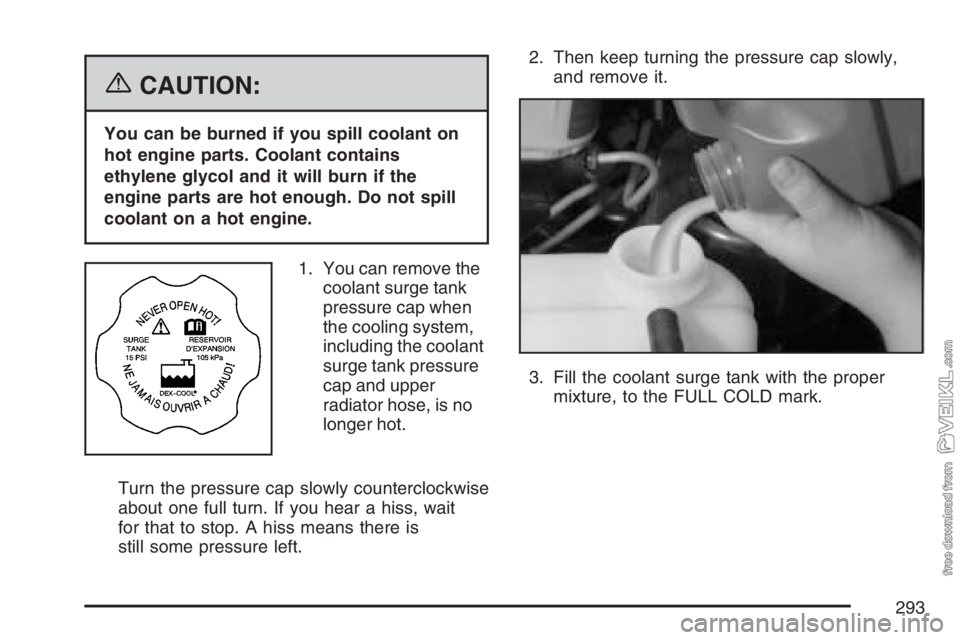
{CAUTION:
You can be burned if you spill coolant on
hot engine parts. Coolant contains
ethylene glycol and it will burn if the
engine parts are hot enough. Do not spill
coolant on a hot engine.
1. You can remove the
coolant surge tank
pressure cap when
the cooling system,
including the coolant
surge tank pressure
cap and upper
radiator hose, is no
longer hot.
Turn the pressure cap slowly counterclockwise
about one full turn. If you hear a hiss, wait
for that to stop. A hiss means there is
still some pressure left.2. Then keep turning the pressure cap slowly,
and remove it.
3. Fill the coolant surge tank with the proper
mixture, to the FULL COLD mark.
293
Page 294 of 430
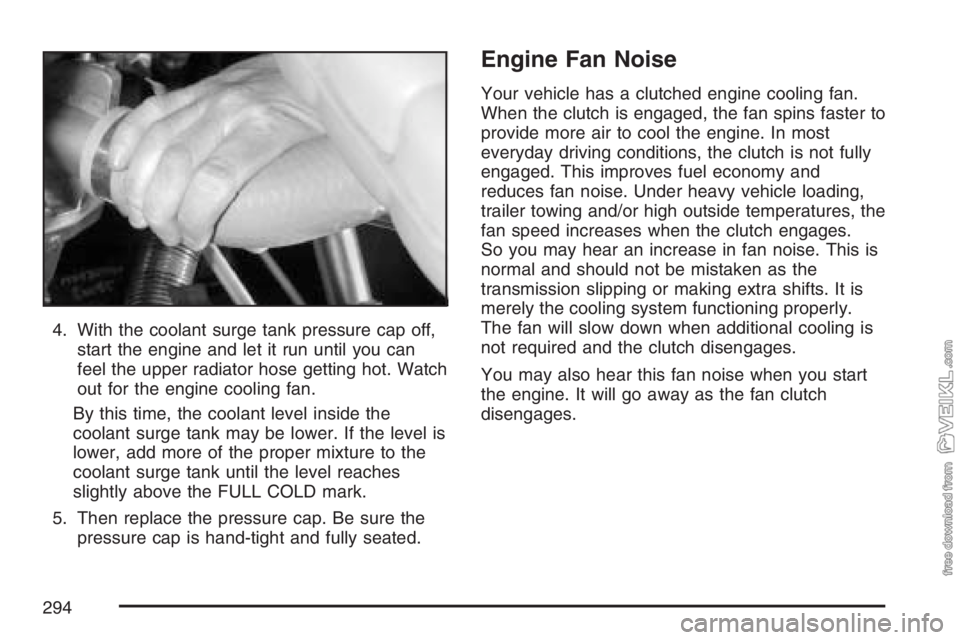
4. With the coolant surge tank pressure cap off,
start the engine and let it run until you can
feel the upper radiator hose getting hot. Watch
out for the engine cooling fan.
By this time, the coolant level inside the
coolant surge tank may be lower. If the level is
lower, add more of the proper mixture to the
coolant surge tank until the level reaches
slightly above the FULL COLD mark.
5. Then replace the pressure cap. Be sure the
pressure cap is hand-tight and fully seated.
Engine Fan Noise
Your vehicle has a clutched engine cooling fan.
When the clutch is engaged, the fan spins faster to
provide more air to cool the engine. In most
everyday driving conditions, the clutch is not fully
engaged. This improves fuel economy and
reduces fan noise. Under heavy vehicle loading,
trailer towing and/or high outside temperatures, the
fan speed increases when the clutch engages.
So you may hear an increase in fan noise. This is
normal and should not be mistaken as the
transmission slipping or making extra shifts. It is
merely the cooling system functioning properly.
The fan will slow down when additional cooling is
not required and the clutch disengages.
You may also hear this fan noise when you start
the engine. It will go away as the fan clutch
disengages.
294
Page 295 of 430
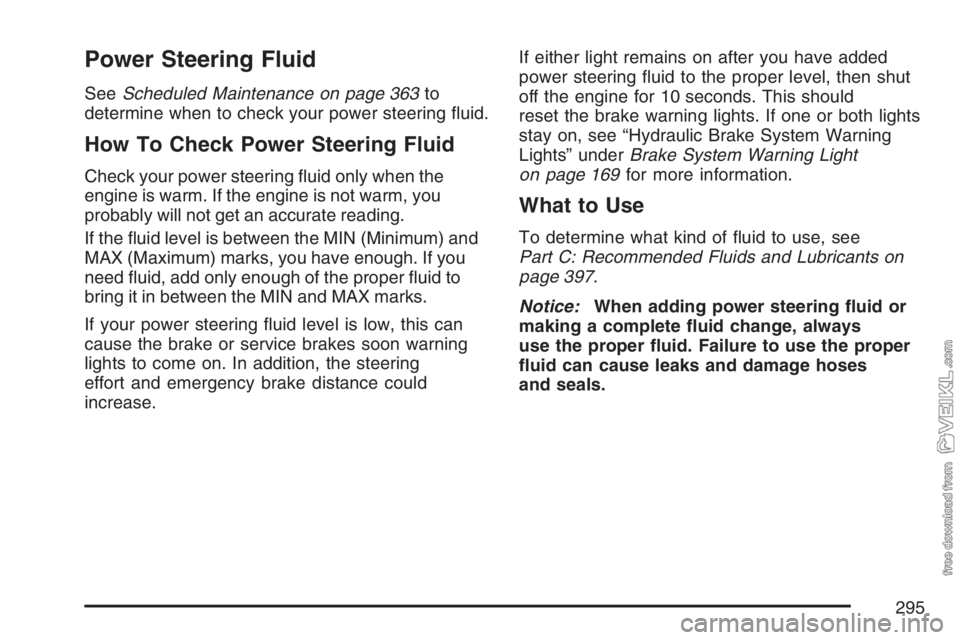
Power Steering Fluid
SeeScheduled Maintenance on page 363to
determine when to check your power steering fluid.
How To Check Power Steering Fluid
Check your power steering fluid only when the
engine is warm. If the engine is not warm, you
probably will not get an accurate reading.
If the fluid level is between the MIN (Minimum) and
MAX (Maximum) marks, you have enough. If you
need fluid, add only enough of the proper fluid to
bring it in between the MIN and MAX marks.
If your power steering fluid level is low, this can
cause the brake or service brakes soon warning
lights to come on. In addition, the steering
effort and emergency brake distance could
increase.If either light remains on after you have added
power steering fluid to the proper level, then shut
off the engine for 10 seconds. This should
reset the brake warning lights. If one or both lights
stay on, see “Hydraulic Brake System Warning
Lights” underBrake System Warning Light
on page 169for more information.
What to Use
To determine what kind of fluid to use, see
Part C: Recommended Fluids and Lubricants on
page 397.
Notice:When adding power steering �uid or
making a complete �uid change, always
use the proper �uid. Failure to use the proper
�uid can cause leaks and damage hoses
and seals.
295
Page 296 of 430
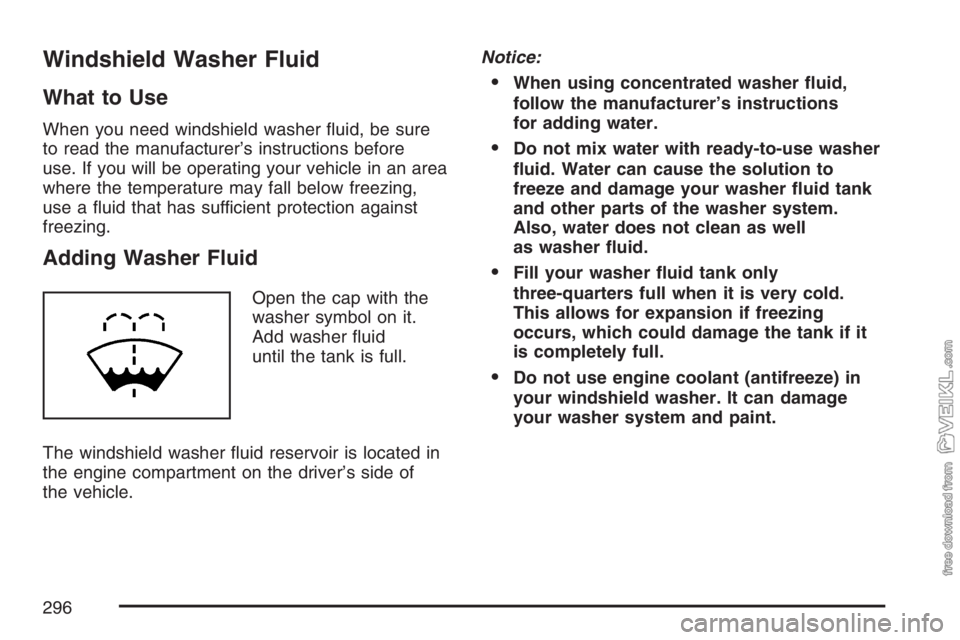
Windshield Washer Fluid
What to Use
When you need windshield washer fluid, be sure
to read the manufacturer’s instructions before
use. If you will be operating your vehicle in an area
where the temperature may fall below freezing,
use a fluid that has sufficient protection against
freezing.
Adding Washer Fluid
Open the cap with the
washer symbol on it.
Add washer fluid
until the tank is full.
The windshield washer fluid reservoir is located in
the engine compartment on the driver’s side of
the vehicle.Notice:
When using concentrated washer �uid,
follow the manufacturer’s instructions
for adding water.
Do not mix water with ready-to-use washer
�uid. Water can cause the solution to
freeze and damage your washer �uid tank
and other parts of the washer system.
Also, water does not clean as well
as washer �uid.
Fill your washer �uid tank only
three-quarters full when it is very cold.
This allows for expansion if freezing
occurs, which could damage the tank if it
is completely full.
Do not use engine coolant (antifreeze) in
your windshield washer. It can damage
your washer system and paint.
296
Page 297 of 430
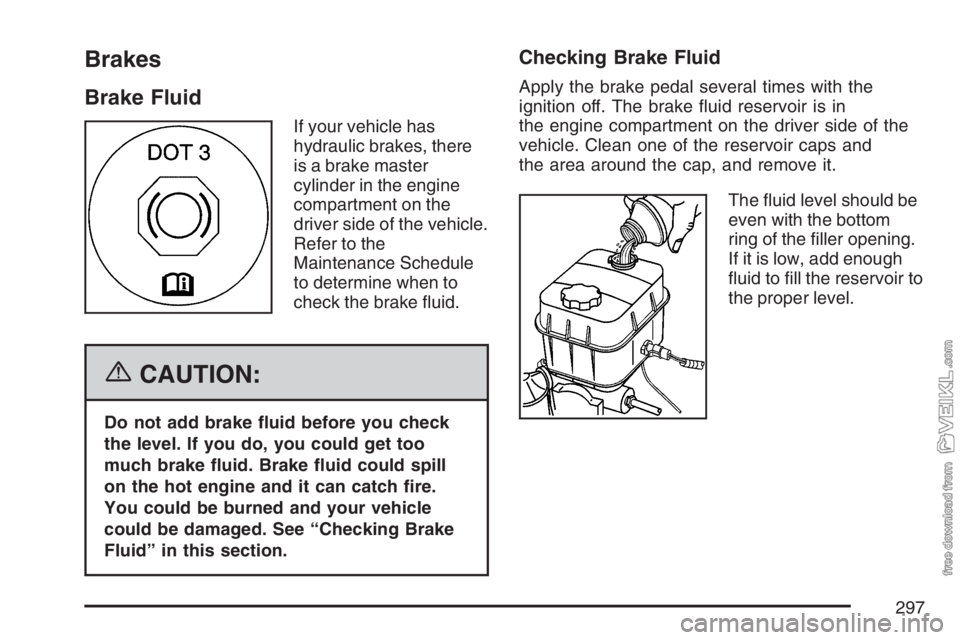
Brakes
Brake Fluid
If your vehicle has
hydraulic brakes, there
is a brake master
cylinder in the engine
compartment on the
driver side of the vehicle.
Refer to the
Maintenance Schedule
to determine when to
check the brake fluid.
{CAUTION:
Do not add brake �uid before you check
the level. If you do, you could get too
much brake �uid. Brake �uid could spill
on the hot engine and it can catch �re.
You could be burned and your vehicle
could be damaged. See “Checking Brake
Fluid” in this section.
Checking Brake Fluid
Apply the brake pedal several times with the
ignition off. The brake fluid reservoir is in
the engine compartment on the driver side of the
vehicle. Clean one of the reservoir caps and
the area around the cap, and remove it.
The fluid level should be
even with the bottom
ring of the filler opening.
If it is low, add enough
fluid to fill the reservoir to
the proper level.
297
Page 298 of 430
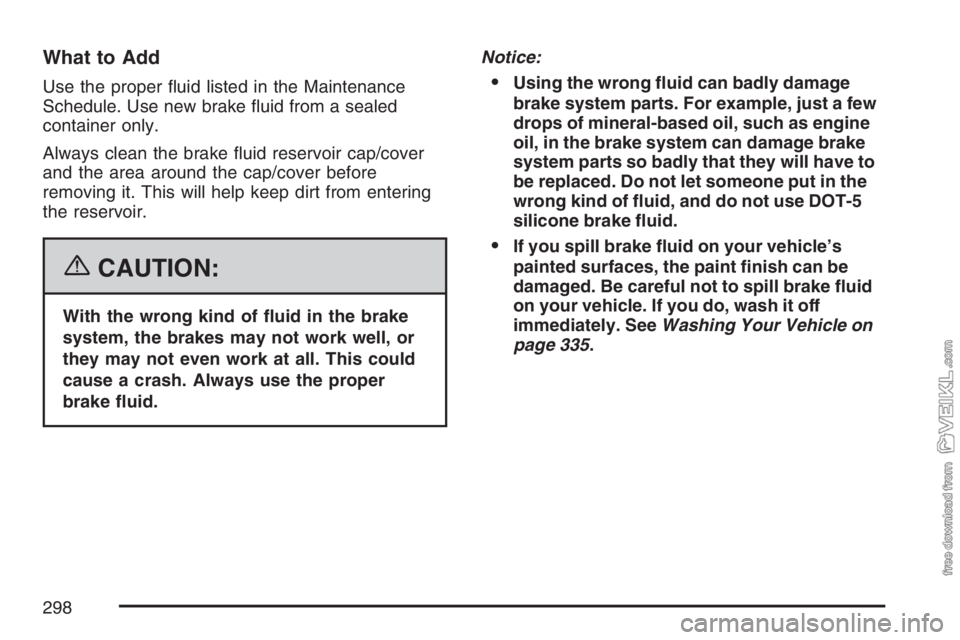
What to Add
Use the proper fluid listed in the Maintenance
Schedule. Use new brake fluid from a sealed
container only.
Always clean the brake fluid reservoir cap/cover
and the area around the cap/cover before
removing it. This will help keep dirt from entering
the reservoir.
{CAUTION:
With the wrong kind of �uid in the brake
system, the brakes may not work well, or
they may not even work at all. This could
cause a crash. Always use the proper
brake �uid.Notice:
Using the wrong �uid can badly damage
brake system parts. For example, just a few
drops of mineral-based oil, such as engine
oil, in the brake system can damage brake
system parts so badly that they will have to
be replaced. Do not let someone put in the
wrong kind of �uid, and do not use DOT-5
silicone brake �uid.
If you spill brake �uid on your vehicle’s
painted surfaces, the paint �nish can be
damaged. Be careful not to spill brake �uid
on your vehicle. If you do, wash it off
immediately. SeeWashing Your Vehicle on
page 335.
298
Page 299 of 430
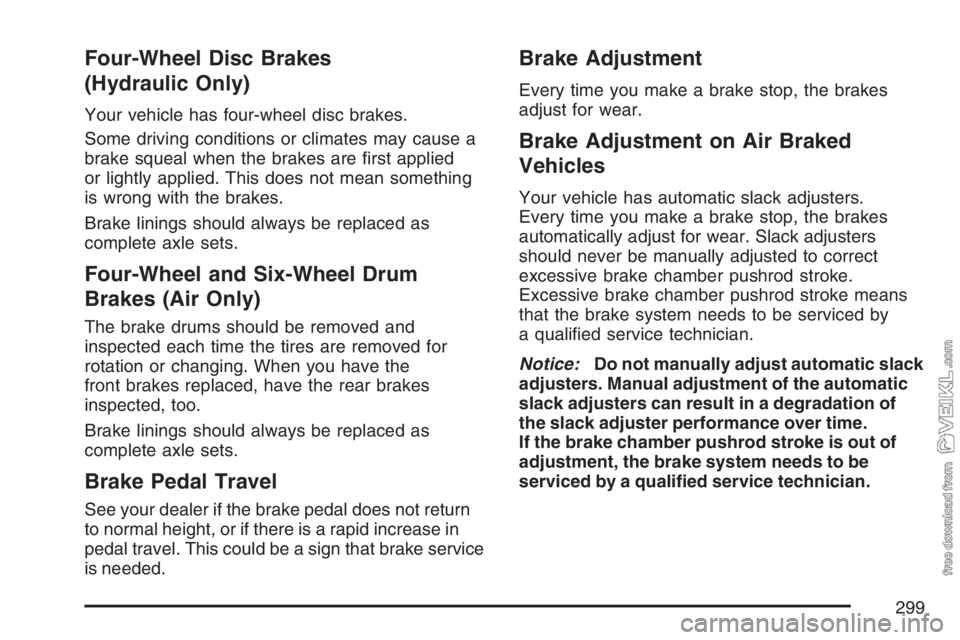
Four-Wheel Disc Brakes
(Hydraulic Only)
Your vehicle has four-wheel disc brakes.
Some driving conditions or climates may cause a
brake squeal when the brakes are first applied
or lightly applied. This does not mean something
is wrong with the brakes.
Brake linings should always be replaced as
complete axle sets.
Four-Wheel and Six-Wheel Drum
Brakes (Air Only)
The brake drums should be removed and
inspected each time the tires are removed for
rotation or changing. When you have the
front brakes replaced, have the rear brakes
inspected, too.
Brake linings should always be replaced as
complete axle sets.
Brake Pedal Travel
See your dealer if the brake pedal does not return
to normal height, or if there is a rapid increase in
pedal travel. This could be a sign that brake service
is needed.
Brake Adjustment
Every time you make a brake stop, the brakes
adjust for wear.
Brake Adjustment on Air Braked
Vehicles
Your vehicle has automatic slack adjusters.
Every time you make a brake stop, the brakes
automatically adjust for wear. Slack adjusters
should never be manually adjusted to correct
excessive brake chamber pushrod stroke.
Excessive brake chamber pushrod stroke means
that the brake system needs to be serviced by
a qualified service technician.
Notice:Do not manually adjust automatic slack
adjusters. Manual adjustment of the automatic
slack adjusters can result in a degradation of
the slack adjuster performance over time.
If the brake chamber pushrod stroke is out of
adjustment, the brake system needs to be
serviced by a quali�ed service technician.
299
Page 300 of 430
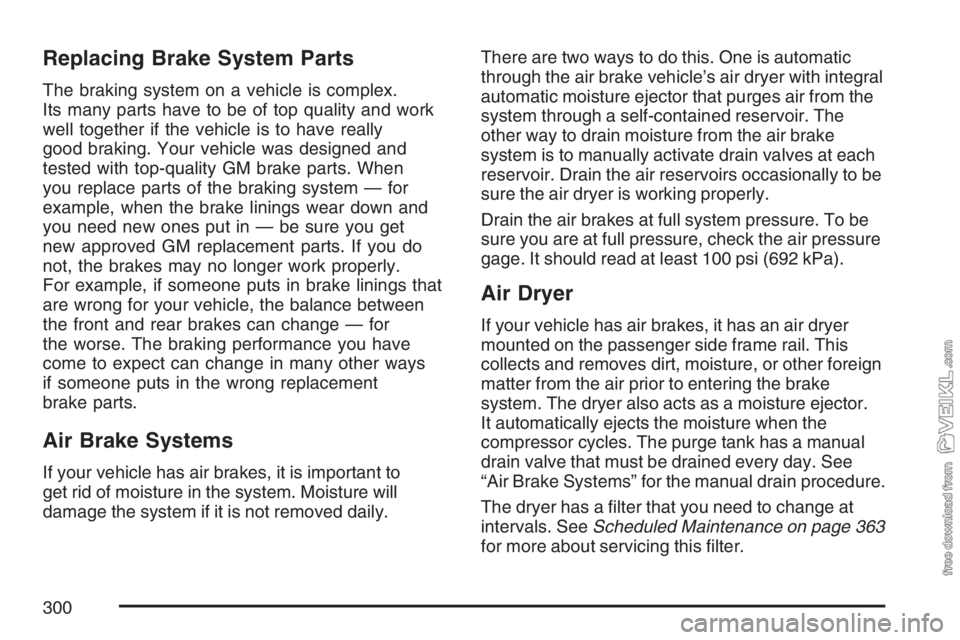
Replacing Brake System Parts
The braking system on a vehicle is complex.
Its many parts have to be of top quality and work
well together if the vehicle is to have really
good braking. Your vehicle was designed and
tested with top-quality GM brake parts. When
you replace parts of the braking system — for
example, when the brake linings wear down and
you need new ones put in — be sure you get
new approved GM replacement parts. If you do
not, the brakes may no longer work properly.
For example, if someone puts in brake linings that
are wrong for your vehicle, the balance between
the front and rear brakes can change — for
the worse. The braking performance you have
come to expect can change in many other ways
if someone puts in the wrong replacement
brake parts.
Air Brake Systems
If your vehicle has air brakes, it is important to
get rid of moisture in the system. Moisture will
damage the system if it is not removed daily.There are two ways to do this. One is automatic
through the air brake vehicle’s air dryer with integral
automatic moisture ejector that purges air from the
system through a self-contained reservoir. The
other way to drain moisture from the air brake
system is to manually activate drain valves at each
reservoir. Drain the air reservoirs occasionally to be
sure the air dryer is working properly.
Drain the air brakes at full system pressure. To be
sure you are at full pressure, check the air pressure
gage. It should read at least 100 psi (692 kPa).
Air Dryer
If your vehicle has air brakes, it has an air dryer
mounted on the passenger side frame rail. This
collects and removes dirt, moisture, or other foreign
matter from the air prior to entering the brake
system. The dryer also acts as a moisture ejector.
It automatically ejects the moisture when the
compressor cycles. The purge tank has a manual
drain valve that must be drained every day. See
“Air Brake Systems” for the manual drain procedure.
The dryer has a filter that you need to change at
intervals. SeeScheduled Maintenance on page 363
for more about servicing this filter.
300